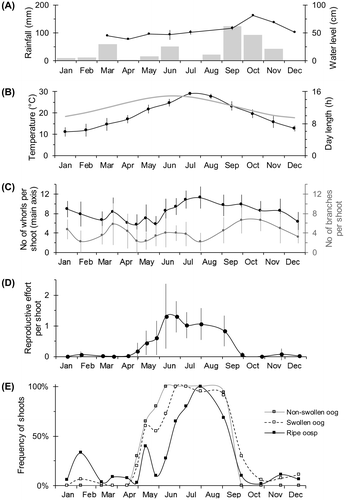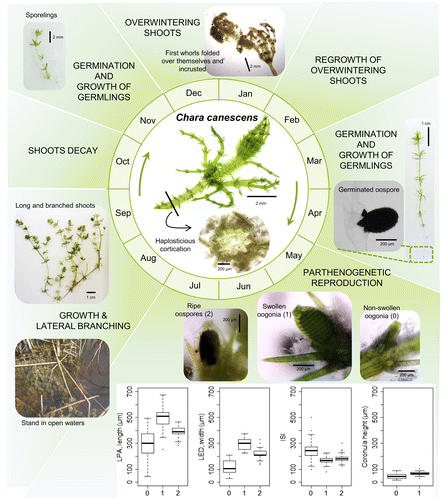Figures & data
Figure 1. (A) The location and aerial photograph of the interdunal pond studied; taken by Matthieu Lasalle in 2015. (B) Basic features of water from the pond. TP: Total phosphorus; TN: Total nitrogen.

Figure 2. (A) The accumulated rainfall (bars) and the water level in the pond per month (line, mean ± SD when more than one value available). (B) The daily air temperature per month (black line, mean ± SD) at the surface of the pond, and the duration of the day (grey line) in Valencia, Spain. (C) The number of whorls of the main axis (black line) and the number of primary branches per shoot throughout the year (grey line) (mean ± SD by sampling date). (D) The reproductive effort per shoot (mean ± SD by sampling date), expressed as the number of fertile whorls per shoot (including lateral branches) divided by the number of whorls of the main axis. The higher values correspond to a higher proportion of fertile whorls per shoot, but also to a more lateral branching (presence of fertile multi-axis individuals). (E) The relative frequency of the shoots with each considered phenophase (non-swollen oogonia, swollen oogonia, ripe oospores) throughout the year, expressed as a percentage.

Figure 3. The life cycle of a parthenogenetic population of Chara canescens in the interdunal Mediterranean pond studied. The different events are distributed throughout the months of the year in a circular diagram. At the bottom, some boxplots show the distributions of the dimensions data measured for the fructifications (LPA: longest polar axis, including the coronula in oogonia; LED: largest equatorial diameter; ISI: isopolarity index; 0: non-swollen oogonia; 1: swollen oogonia; 2: ripe oospores).

Figure 4. The distribution of the frequencies of all the measured oogonia and oospores in the different months of the year, according to their position within the shoot (number of whorl from the apex).

Figure 5. (A) The size relationship of the oogonia and (B) the oospores from the studied population of Chara canescens, including the respective logarithmic and linear relationships (p < 0.001) between their two main biometric characteristics (LED: largest equatorial diameter; LPA: longest polar axis). As the data are overlapping, the point size is proportional to the frequency of the oogonia/oospores in each case. The histograms of the frequencies for the two variables are also shown. The dashed lines show the LED value that was considered as the threshold for the swollen oogonia.

